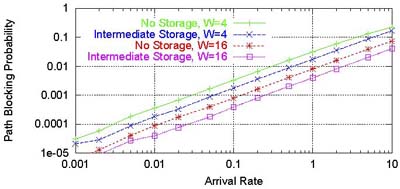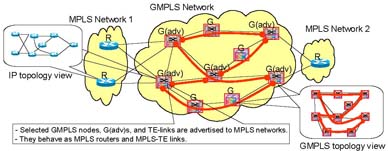|
 |
Program
1. Program at a Glance
| Monday 21, February 2005 |
Hall 300 |
Hall 500 |
|
9:40-10:50 |
Opening address
- Prof. Tomonori Aoyama, Univ. of Tokyo
- Dr. Bijan Jabbari, ISOCORE
Keynote
- Dr. Rajiv Ramaswami, Cisco Systems
Program introduction
- Mr. Tadanobu Okada, TPC Chair, NTT
|
| 11:00-12:30 |
Special session 1:Toward truly interoperable IP and optical networking products and services
- Mr. Rajiv Papneja, ISOCORE
- Prof. Naoaki Yamanaka, PIL (Keio Univ.)
- Ms. Amy Wang, OIF |
| 12:30-13:30 |
Break |
| 13:30-16:00 |
Special session 2: Project report:IP+Optical testbed
- Prof. Shoichiro Asano, NII
- Dr. Tatsuzo Koga, JGN II Research Center
- Prof. G. S. Kuo, National Chengchi Univ. in Taipei and Beijing Univ. of Posts and Telecommunications in Beijing
- Prof. Ken-ichi Kitayama, Osaka Univ.
- Mr. Jerry Sobieski, Mid-Atlantic Crossroads
|
16:10-16:50
Public Demonstration
(GMPLS Interop Showcase) |
|
|
| |
17:00-18:00 |
Special session 3: Visions for the Next Generation IP+Optical Network Research and Development
- Mr. Hisao Iizuka, NTT Communications
- Dr. Masatoshi Suzuki, KDDI Labs |
19:00-19:20
Public Demonstration |
|
|
| 20:00 close |
| Tuesday 22, February 2005 |
Hall 300 |
Hall 500 |
|
Exhibition
10:00 - 14:30 |
9:30-11:10 |
Tech. Session 1: Multi-layer : IP+Optical
- Mallik Tapipamula, Cisco Systems
- Keiji Miyazaki, Fujitsu
- Jonathan Sadler, Tellabs
- Takashi Kurimoto, NTT
- Dimitri Papadimitriou, Alcatel
|
10:00-10:20
Public Demonstration |
| |
| 11:20-12:20 |
Tech. Session 2: New Services: VPN, QoS, Grid
- Eiichi Horiuchi, Mitsubishi Electric
- Tomonori Takeda, NTT
- Hiroaki Harai, NICT |
12:30-12:50
Public Demonstration |
12:20-13:20 |
Break |
| 14:30 close |
13:20-14:40 |
Tech. Session 3: Migration scenario to GMPLS networks
- Arthi Ayyangar, Juniper Networks
- Hideomi Ishizuka, Sycamore - Networks Japan
- Zafar Ali, Cisco Systems
- Eiji Oki, NTT |
| |
| 14:50-15:50 |
Tech. Session 4: Implementation report experiments
- Shuichi Okamoto, NICT
- Yoshihiro Nakahira, Oki
- Itaru Nishioka, NEC |
| Opening address |
 "Optical Networks: Challenges and Opportunities. " "Optical Networks: Challenges and Opportunities. "
Dr. Bijan Jabbari (ISOCORE)
Over the past several years, the consolidation of the carriers and the high cost of photonic devices have curtailed the wide-spread introduction and implementation of the optical networks. However, the situation is beginning to change due to innovations at the device and system levels, as well as the progress made in integrating control plane software. These developments along with creative economical architectures achieve a pragmatic introduction of the optical networks to address arising demand and service opportunities. This presentation will take a look at these enabling technology innovations and discuss how economically driven solutions are reviving this industry. |
| Keynote Speech |
 gIP + Optical in the Next Generation Networkh gIP + Optical in the Next Generation Networkh
Dr. Rajiv Ramaswami (Cisco Systems)
Monday, 21 February 2005, 10:05- 10:45
Outline: The next generation network is about convergence of multiple services on to a single IP+optical network. The talk presents a broad overview of how IP and optical technologies are coming together in the network to provide tangible benefits for service providers. In the core network we will see tight integration of IP and DWDM in terms of combined network designs, wavelength interfaces on routers, and an integrated control plane across the IP and DWDM layers. In the metro/access part of the network we will see significant integration of layer 2 and layer 3 functions into next-gen SDH platforms to provide data services to the end user.
Biography: Rajiv is Vice President and General Manager for Ciscofs Optical Group, where he is responsible for driving Ciscofs optical business and leading engineering and marketing teams developing metro optical products. Rajiv has worked on optical networks for 15 years, from early research to product development to network deployment, at IBM Research, Tellabs, Xros, and Nortel Networks. He is an IEEE Fellow and a recipient of the IEEE W. R. Bennett and W.R.G. Baker prize paper awards. He is also a Distinguished Alumnus of the Indian Institute of Technology, Madras and coauthor of a book, Optical Networks-A Practical Perspective. Rajiv has a Ph.D. in electrical engineering from the University of California, Berkeley.

|
| Special Sessions |
S1. Toward truly interoperable IP and optical networking products and services
Monday, 21 February 2005, 11:00 ~ 12:30
Coordinator: Kohei Shiomoto (NTT Network Service Systems Labs.)
Session Description: A combined IP and optical network is a promising network architecture to cope with traffic growth brought about by aggressive penetration of broadband services. Several standardization organizations and forums, including IETF, ITU, and OIF, are undertaking network architecture design, requirement specification, and standardization of protocols to achieve interoperable IP and optical networking products and services. The standardization attempt encompasses control, data, and management planes. In the control plane space, signaling, routing, and link management protocols are being standardized. GMPLS-extensions for OSPF and RSVP-TE, and LMP are developed by IETF. OIF-UNI/ENNI Implementation Agreements are being developed in OIF.
In order to achieve truly interoperable IP and optical network products and services, interoperability tests and feedbacks of new findings from the tests are quite important. Several interoperability labs and forums are conducting interoperability tests hosting various network equipment vendors and service providers. This special session is organized to address interoperability test efforts undertook by three prominent bodies: ISOCORE, Photonic Internet Lab (PIL), and Optical Internetworking Forum (OIF). Goals and missions of those bodies are presented. Prominent past activities and associated new findings are reported. Plans for the future activities are discussed. |
 S1-1. IP-Optical Integration: From Concept to Validation - An update from Isocore Internetworking Lab S1-1. IP-Optical Integration: From Concept to Validation - An update from Isocore Internetworking Lab
Mr. Rajiv Papneja (ISOCORE)
In the past few years, the industry has made considerable progress toward optical control plane internetworking and multi-vendor, multi-layer interoperability.A variety of standards initiatives seek to establish open, defined interfaces within the Optical Transport Networks (OTN) and between the OTN and the IP service layer.
This presentation aims to discuss the progress made in the last couple of years in terms of the stability of the implementations and the increase in the level of interoperability amongst the IP and Optical Transport devices. The talk will present the recommended best common practices in terms of GMPLS addressing, control channel deployment scenarios that are currently used in various IP-Optical Integration test efforts, including the one being locally demonstrated at iPOP 2005. We will also present some of the key observations from the past IP-Optical demonstrations held by Isocore Internetworking lab with support from its member companies. The presentation will provide an overview of the industry's first multi-vendor IP-Optical demonstration at Supercomm 2004 and MPLS 2004 International Conference as well as plans for future testing activities.
Biography: Rajiv Papneja holds MS, Electrical Engineering from George Mason University, Virginia, USA. Mr. Papneja has over 7 years of experience of research and industry experience in the field of emerging IP technologies including MPLS and advanced optical networks. Currently he is a Manager of Product Evaluation and Validation at Isocore. |
 S1-2. Photonic-GMPLS Leading Edge Code Research Consortium:Photonic Internet Lab. (PIL) S1-2. Photonic-GMPLS Leading Edge Code Research Consortium:Photonic Internet Lab. (PIL)
Prof. Naoaki Yamanaka (Photonic Internet Lab)
Photonic Internet Lab. (PIL) is shooting for the leading edge photonic-GMPLS (Generalized Multi-protocol Label Switching) that utilizes wide-band, cost-effective photonic technology to implement IP-centric managed networks. PIL is a consortium for researching the GMPLS protocol and advancing a de facto standard in this area. Members make leading edge GMPLS code modules and test them at the lab site. The experimental results, new ideas, and protocols are contributed to standardization bodies such as IETF and OIF. This paper also describes the worldfs first trial of MPLS /GMPLS interworking with multi-region multi-layer multi-route, multi-vender equipments.

Biography: In 1983 Dr. Yamanaka joined Nippon Telegraph and Telephone Corporationfs (NTTfs) Communication Switching Laboratories, Tokyo Japan, where he was engaged in research and development of a high-speed switching system and high-speed switching technologies for Broadband ISDN services. Since 1994, he has been active in the development of ATM base backbone network and system including Tb/s electrical/optical backbone switching as NTTfs Distinguished Technical Member. He is now researching future optical IP network, and optical burst switching system. He is currently a Professor in Dept. of Information and Computer Science, Keio University, Japan and representative of Photonic Internet Labs. He has published over 122 peer-reviewed journal and transaction articles, written 82 international conference papers, and been awarded 174 patents including 17 international patents. Dr. Yamanaka received Best of Conference Awards from the 40th, 44th, and 48th IEEE Electronic Components and Technology Conference in 1990, 1994 and 1998, IEEE CPMT Transactions Part B: Best Transactions Paper Award in 1996 and IEICE Transaction Paper award in 1999. Dr. Yamanaka is an IEEE Fellow and a member of the IEICE. |
 S1-3. Success of Large Scale Control Plane Internetworking: An Update from the OIF S1-3. Success of Large Scale Control Plane Internetworking: An Update from the OIF
Ms. Amy Wang (Optical Internetworking Forum)
This talk will provide high-level introduction of the OIF organization, itfs working groups and how the organization contributes to the network industry in the area of IP optical integration. Key Implementation Agreements including OIF UNI 1.0 Release 2 and OIF E-NNI 1.0 Intra-Carrier Signaling will be summarized. In addition, this talk will also briefly describe the collaborative relationships of OIF and other industry standard bodies including ITU, IETF, MEF, TMF, etc.
A significant portion of this presentation will be focused on OIFfs achievement on the interoperability front. In the past several years, OIF successfully conducted multiple interoperability events in the area of IP optical area to demonstrate multi vendor control plane, data plane interoperability. The steps of putting together a large-scale interoperable network will be revealed. Detailed results and the technical findings of the Supercomm 2004 World Interoperability Demonstration will be reviewed. This event featured total of seven carriers worldwide participated the global testing in three continents with fifteen vendorsf support.
Multi vendor, multi domain distributed control plane interoperability ran over seven different carrier sites. In addition, Ethernet adaptation using GFP-F, VCAT and LCAS over SDH/SONET was also tested.

Biography: Amy Wang is a senior product line manager at Avici Systems. She is responsible for Avicifs product management and marketing strategy in the area of IP optical integration. She has served as the Interoperability Working Group co-chair of Optical Interworking Forum for the last two years, where the focus is to achieve multi-vendor, open standard next generation IP-optical networks through technical Implementation Agreement and multi-vendor interoperability testing and demonstration. Previously, Wang was the senior member of science staff at Nortel working on Voice over ATM and Centrex business features. She also worked as a system analyst in Corning prior to that. She has a MS in Electrical and Computer Engineering from University of Tennessee, Knoxville. |
S2. Project report: IP+Optical testbed
Monday, 21 February 2005, 13:30 ~ 16:00
Coordinator: Akira Chugo (Fujitsu Ltd.)
Session Description: IP and optical network technologies encompasses several technological components: hardware devices, node systems, control-plane protocols, network management systems, etc. These components are being developed individually at the early R&D stage of IP and optical networks. To make the IP+Optical networking technologies a reality, it is not enough to conduct individual R&D efforts for these technological components. It is necessary to evaluate the overall network that comprises those technological components. Moreover, it is necessary to acquire operation know-how and new findings for the IP+Optical network using a testbed network based on those technological components through operation experience.
These activities are not feasible by a single R&D organization. Multiple organizations should jointly collaborate to build up the IP and optical network testbed and conduct experiments. Several national projects and industry-academia projects are now underway in various countries and regions in the world. These projects are targeting various research goals related to the next generation network such as GRID services, multi-layer TE, network control and management based on GMPLS/G.ason, optical network control and devices, optical burst switching, etc.
In this session, the delegates from the testbed projects are invited to present their activities and share their views on the IP and optical networking technologies. |
 S2-1. Feasibility Test on Photonic Technologies for developing Japanese Science Cyber-Infrastructure S2-1. Feasibility Test on Photonic Technologies for developing Japanese Science Cyber-Infrastructure
Prof. Shoichiro Asano (National Institute of Information),
Co-editor: Dr. Shiro Ryu, Mr. Mikio Yagi (Japan Telecom)
National Institute of Informatics (NII) has been conducting researches, jointly with Japan-Telecom, to develop an optical transport system with 40Gbps for the next generation Cyber Science Infrastructure in Japan. We report the recent results of field trials focused on automatic chromatic dispersion compensation and path protection/restoration as the key technologies to maintain the quality of transmission, to reduce operational cost as well as to facilitate the enhancement of network capabilities.? From the results of the field trial, we have made sure that the automatic optical path control system is essential for all-optical wavelength path network.

Biography: Shoichiro Asano?had graduated at Electronic Engineering, Faculty of Engineering, University of Tokyo, in 1970.?? He received ME and DE, both from University of Tokyo, in 1972 and 1975 respectively.? Dr. Asano is a Director and Professor, Infrastructure Systems Research Division, National Institute of Informatics (NII) and a Professor, Graduate School of Information Science and Technology, University of Tokyo.? His current researches are mainly focused on optical network architecture and development of SuperSINET in Japan. |
 S2-2. Japan Gigabit Network (JGN) II and A Research Project on GMPLS at Tsukuba JGN II Research Center S2-2. Japan Gigabit Network (JGN) II and A Research Project on GMPLS at Tsukuba JGN II Research Center
Dr. Tatsuzo Koga (Tsukuba JGN II Research Center of National Institute of Information and Communications Technology / Director)
Japan Gigabit Network II (JGN II) is a testbed network provided by National Institute of Information and Communications Technology (NICT) for the purpose of promoting research and development of advanced networking technologies and network-related applications in collaboration with universities, public and private research institutions, industries, and local communities. The testbed has a maximum capacity of 20 Gbps and provides sixty-three access points located at least one in each Prefecture throughout Japan. It has been in operation since April 2004. Tsukuba JGN II Research Center (Tsukuba RC) is one of seven research centers established within the framework of the JGN II project. JGN connects between Tsukuba RC and Otemachi JGN II Research Center (Otemachi RC) in Tokyo at a maximum rate of 10 Gbps for regular services (L2 and L3). Optical testbed services are also available between Tsukuba RC and Otemachi RC under special arrangements (L1). This presentation gives an outline of JGN II and the research activities of Tsukuba RC placing emphasis on one of its core research themes gGMPLS Network Operation and Management Technologyh.
Biography: Dr. Tatsuzo Koga has been with NICT (National Institute of Information and Communications Technology) serving as Director of Tsukuba JGNR II Research Center since April 2004. His professional carrier includes 1999-2004: Director, Tsukuba Gigabit Laboratory, Telecommunications Advancement Organization of Japan, 1981-1999: University of Tsukuba (Professor of Applied Mechanics, Dean, Provost, Vice President), 1969-1981: National Aerospace Laboratory (Principal Scientist, Head). Dr. Koga graduated from the University of Tokyo in 1961. He earned his PH.D. in Aeronautics and Astronautics from Stanford University in 1968.
 |
 S2-3. Some Key Technologies on Future Optical IP Networks S2-3. Some Key Technologies on Future Optical IP Networks
Prof. Geng-Sheng (G.S.) Kuo, Xiaohua Ma, Qing Huang, Hai-Bo Guo, Yong Yin, Yao Dong, Wei Qin, Xin Xie and Ling Wang. (Beijing University of Posts and Telecommunications, Beijing, China National Chengchi University, Taipei.)
This presentation is to discuss some key technologies on future optical IP networks. Four topics will be mainly concentrated on. The first one is the control plane in GMPLS-based IP networks. The second is the routing wavelength assignment (RWA) in GMPLS-based IP networks. The third is the protection and restoration in GMPLS-based IP networks. And, the last is the design of MOEMS-based GMPLS-oriented optical switching system.

Biography: Geng-Sheng (G.S.) Kuo (gskuo@ieee.org) received his Ph.D. degree in Systems Engineering from Case Western Reserve University, Cleveland, Ohio, U.S.A. in 1982. He then worked with R&D laboratories of the communications industry in the United States, such as AT&T Bell Laboratories, etc. Currently, he is a professor of National Chengchi University, Taipei, Taiwan. From February to August, 2004, he visited Beijing University of Posts and Telecommunications in Beijing, China, gave a series of lectures, and guided many students. His current research interests include wireless communications, mobile communications, optical MEMS-based optical switch, broadband switching router, and broadband IP networks. From 1999 - 2001, he was Chair of Communications Switching & Routing Technical Committee, IEEE Communications Society. From 2001 - 2002, he was Editor-in-Chief of IEEE Communications Magazine. Currently, he is Area Editor for Networks Architecture of IEEE Transactions on Communications, Editor of IEEE Communications Surveys & Tutorials, Editor and IEEE Communications Society Representative to IEEE Internet Computing, Editor of Computer Networks, Editor of Wireless Communications & Mobile Computing, and Editor of Wireless Personal Communications: An International Journal (WIRE). Furthermore, he was the IEEE Communications Society Representative to IEEE NanoTechnology Council from 2002 to 2003. He is Co-Vice Director of Asia Pacific Board of IEEE Communications Society, a member of Award Committee for IEEE Communications Society, and a member of New Technology Direction Committee (NTDC) for IEEE Technical Activity Board (TAB). In addition, he has been the chair or vice-chair of TPC for many IEEE international conferences, symposia and workshops, e.g., ICC 2000, Globecom 2002, ICC 2008. He has published many technical papers in the refereed international journals and conferences. |
 S2-4. R&D Activities in Optical Network Testbed at NiCT Keihanna Open Laboratory S2-4. R&D Activities in Optical Network Testbed at NiCT Keihanna Open Laboratory
Prof. Ken-ichi Kitayama (Osaka Univ.)
Since April 2004 Japan Gigabit Network, JGN II was launched by National Institute of Information and Communication Technology, NiCT, it has been open to public and a center of R&Ds for next generation networks and their applications. JGN II provides up-to-date optical network testbeds in Keihanna (west) and Tokyo (east). In this talk, the optical network testbeds, which have been intensively utilized for R&Ds by carriers, vendors, and universities, are introduced. Some topics of the recent R&D activities of optical networking experiments on optical burst switching, wavelength- and packet-selective OADM, and waveband switching will be presented.

Biography: Ken-ichi Kitayama received the M.E., and Dr. Eng. degrees in communication engineering from Osaka University, Osaka, Japan in 1976 and 1981, respectively. In 1976, he joined the NTT Laboratories. In 1995, he joined the Communications Research Laboratory (Presently NICT), Tokyo. Since 1999, he has been the Professor of the Department of Electronic and Information Systems Engineering, Graduate School of Engineering of Osaka University. He is the Fellow of IEEE and the Fellow of IEICE of Japan. |
 S2-5. The DRAGON Project: Dynamic Resoource Allocation over GMPLS Optical Networks S2-5. The DRAGON Project: Dynamic Resoource Allocation over GMPLS Optical Networks
Mr. Jerry Sobieski (Mid-Atlantic Crossroads)
This presentation will introduce several scientific applications which require high bandwidth transport across multiple domains and discuss the solution based on dynamically managed deterministic services. The use of GMPLS (Generalized MultiProtocol Label Switching) in the all-optical networks provides an attractive approach lending itself to fulfill the required degree of scalability. The approach is deployed as part of an experimental high end scientific application network referred to as DRAGON, a multi-year research project funded by the US National Science Foundation (NSF).
The talk will also contrast such solutions with other IP best effort services augmented by QoS. The experimental prototype implementation of the proposed solution, based on revising open source codes, and adapting them to provide the required protocol functionality will also be described.

Biography:Jerry Sobieski currently serves as the Director of Network Research Initiatives for the Mid-Atlantic Crossroads (MAX) - a collaborative organization of universities and research labs in the Washington DC region. Mr. Sobieski is responsible for setting strategic technical direction for the organization, identifying advanced technology that will be required to address these future needs, and developing collaborative research and development programs to pursue these objectives.
Mr. Sobieski leads the NSF DRAGON Project ? a research testbed in Washington DC exploring dynamic, all-optical wavelength provisioning. He is currently a member of the Internet2 Abilene Technical Advisory Committee as well a member of the Internet2 Hybrid Optical/Packet Infrastructure (HOPI) Design Team. Mr Sobieski has worked in a number of capacities in both the private sector and the academic research community in areas of advanced network services and parallel and distributed computing for both business and science.
Mr. Sobieski received his degree in Computer Science from the University of Houston in 1985. He currently resides outside Washington, DC in suburban Maryland with his wife and 3 children. |
S3.Visions for the Next Generation IP+Optical network Research and Development
Monday, 21 February 2005, 17:00 ~ 18:00
Coordinator: Akira Chugo (Fujitsu Ltd.)
Session Description: Due to fierce competition, broadband services are aggressively penetrating the market in Japan. The aggressive penetration of the broadband services is bringing about tremendous growth of traffic volume. In order to cope with such tremendous growth in traffic volume, the IP and optical network is expected to reduce the network cost while achieving enough capacity.
The IP and optical network newly introduced automatic network control mechanisms based on control plane protocols. Those mechanisms are expected to simplify the network operations and create new services such as bandwidth on-demand, optical VPN, QoS, fast failure recovery, etc.
Continuous research and development efforts are important in order to create new revenue generating services while reducing the OPEX/CAPEX. In this session, the heads of R&D in telecom carriers in Japan will talk about the vision of the next generation network and the expectation and approaches for IP+Optical backbone network and GMPLS. |
 S3-1. Approach to Next Generation Carrier-Grade IP Transport Networks S3-1. Approach to Next Generation Carrier-Grade IP Transport Networks
Mr. Hisao Iizuka (NTT Communications Corporation)
Scalability, reliability and serviceability to meet customerfs needs are required to carrierfs IP transport networks with increasing the importance of IP-based services (e.g., VoIP) and the role of IP networks as a lifeline.
In the conventional carrierfs networks, network operator is necessary to coordinate network resources among network layers for providing an end-to-end path, because network provisioning has been manually performed with respect to each network layer. However, in the future networks, automated provisioning over multiple network layers will be important for rapid service delivery and cost-effective network operation. Moreover, autonomous recovery mechanism from network failure or disaster should be implemented for rapid network recovery into the future networks as a lifeline.
GMPLS is a remarkable technology for the future carrier-grade IP transport networks, because control plane provided by GMPLS enables the transparent network control over multiple network layers. This feature will promise to simplify network operation and resource management, and to enhance network function such as autonomous multi-layer traffic engineering.
In this presentation, business strategy for IP networks of NTT Communications which responds to the changes in circumstances surrounding IP networks will be shown. And development strategy for next generation carrier-grade IP transport networks with GMPLS technology will also be discussed.
 Biography
Biography: Mr. Hisao Iizuka is Executive Vice President and Network Management Value President of NTT Communications Corporation, Japan. As the Executive Manager of Innovative IP Architecture Center of the company, he manages the R&D of IP related products/services including IPv6, wireless access, contents delivery platform, Digital TV transport system, Voice over IP system.
Mr. Iizuka received his B.E. and M.E degrees from Tohoku University in 1970 and from Tokyo Institute of Technology in 1972, respectively. Since joining Nippon Telegraph and Telephone Public Corporation in 1972, he has been active in the research and development of digital switching system, multimedia-related services, and in the international standardization of telecommunication systems.
|
 S3-2. Next Generation IP/Optical Integrated Network in KDDI S3-2. Next Generation IP/Optical Integrated Network in KDDI
Dr. Masatoshi Suzuki (KDDI R&D Laboratories Inc.)
KDDI is the only one carrier providing both fixed and mobile telecommunication service in Japan. In addition to 3G mobile phone and high-speed data services, KDDI has provided the triple play services (voice, data and video over IP ) through the high speed FTTH and CDN. A high quality VoIP service is also provided by the copper access line and all the wired voice service will be shifted to VoIP by the end of 2007. Next generation IP/Optical network is the fundamental infrastructure for providing such the broadband multi-media IP services with high QoS. In this presentation, GMPLS-controlled network technology to establish a low-cost, flexible and reliable IP/Optical network is presented. The benefits of GMPLS networking technology, which enables the integrated operation of IP router, optical cross-connect and WDM equipment, are reduction in network maintenance and operation costs and swifter service provisioning.

Biography: He received his B.E. and Ph.D. degrees in electronics engineering from Hokkaido University, Sapporo, Japan, in 1979 and 1984, respectively. In 1984, he joined KDD (currently KDDI), Tokyo, Japan. Since 1984, he has been engaged in research on high-speed optical devices, soliton transmission, WDM undersea cable systems and optical network. Currently, he is the Executive Director of KDDI R&D Laboratories, Inc. He received the distinguished paper award and the achievement award from IEICE in 1995 and 2004, respectively. He also received the best paper awards from OEC 1988 and OECC 2000. He was an Associate Editor of IEEE Journal of Lightwave Technologies from 1999 to 2004. He is a Senior Member of IEEE and a Member of IEICE. |
| Technical Sessions |
T1. Multi-layer: IP+Optical
Tuesday, 22 February 2005, 9:30 ~ 11:10 |
T1-1. A PCE-based MPLS Traffic Engineering LSP path computation approach
Mallik Tapipamula (Cisco Systems)
(G)MPLS Traffic Engineering has been encountering an increasing deployment success over the past several years for its capabilities to offer efficient traffic engineering (leading to more efficient network resource usage) and fast recovery by means of local protection techniques such as Fast Reroute so as to provide tens of milliseconds of convergence time and bandwidth protection, when required. Although the well-known Head-end CSPF based path computation approach has some ineluctable benefits, there are problem spaces in which other path computation approaches may be more appropriate/efficient, one of which being the PCE (Path Computation Element) approach whereby TE LSP paths are computed by other entities than the Head-end LSR. Such problems have been clearly identified, the subset of which is as follows:
- Computation of optimal and/or diverse TE LSP paths across multiple domains such as IGP areas and Autonomous Systems. Such requirements have been expressed by many Service Providers and are listed in several IETF requirements specifications,
- Dynamic Inter-layers resource optimization (optical, packet layers) for optimization of both the primary traffic and network backup capacity,
- Use of border model whereby the client may have to request the creation of paths from a PCE due to some lack of network and resource topologies information.
This presentation will first provide a description of the problem spaces in term of requirements followed by a description of a PCE-based architecture and its various components such as the dynamic PCE discovery by means of IGP extensions, the PCC (Path Computation Client) ? PCE signalling aspects, the PCE selection algorithms as well as some possible distributed algorithms for inter-area/AS optimal path computation. Finally the confidentiality aspects will also be discussed as they have also been identified as a key requirement. The standardization aspects will also be covered by the presentation.
 |
T1-2. Robust and Efficient Control Method for Multilayered GMPLS Networks
Keiji Miyazaki (Fujitsu)
A new network architecture, which can accommodate a huge traffic volume and reduce operation, administration, and maintenance (OAM) costs, has been expected for the next generation networks. One approach for accommodation of the huge traffic is using photonic technologies such as Wave Division Multiplexing (WDM). However, if only WDM network is used, the number of Lambdas is limited and the operation of the WDM network is not flexible.
In this presentation, we propose a new network architecture called gphotonic virtual routerh. The architecture consists of data plane and control plane based on Generalized Multi-Protocol Label Switching (GMPLS). We also show two operation scenarios, multilayer-Traffic-Engineering scenario and fault-recovery scenario.
In multilayer-TE scenario, automatic operation of a control plane is introduced to reduce OAM costs.
In fault-recovery scenario, a shared mesh recovery is introduced for the robustness and efficiency. And flooding-based fault notification method is proposed for the shared mesh recovery.
We evaluate our proposed method in terms of the protecting / working ratio. Through evaluations, it is shown that our proposed method can reduce the ratio for the shared mesh recovery.
 |
T1-3. Routing for Multi-Layer Networks
Jonathan Sadler (Tellabs)
Many carrier networks consist of optical network elements that support multiple transport technologies, including:
- Ethernet
-PDH (e.g. DS1, DS3, E1, E3, J1)
-SONET/SDH Low Order (e.g. VT1.5/VC11, VT2/VC12, VC3)
-SONET/SDH High Order (e.g. VC3, VC4, VC4-4c, VC4-16c)
While an optical control plane can be limited to operating in one layer network, there are many cases where not knowing the relationship between layer networks will cause paths that are not optimal to be computed by a routing function.As a result, Multi-Layer Network Routing is a desirable control plane behavior.
This presentation will cover how Network Layers are related, the additional information that needs to be advertised by a routing protocol to detail this relationship, and methods used to compute paths over resources in Multi-Layer Networks.

|
T1-4. Multi layer coordination architecture based on multi layer service network for advanced service provision and operation in future IP optical networks
Takashi Kurimoto (NTT)
Recently, high speed accesses are widely deployed such as xDSL and fiber, and new applications started such as content delivery and file exchange. This trend has already started filing up the network capacity and is becoming severer, for example, an order of Tbps is expected at the core network.
In order to effectively handle such growing demand dynamically, we focus on the IP+optical technology based on IP technology such as GMPLS (Generalized Multi Protocol Switching) [1, 2] and OIF [3] signaling and routing technologies, which can control IP routers and optical technology including WDM and OXC. It allows dynamic provision and restoration of the multiple layersf connectivity such as links, and node interfaces in a uniformed way.However, in a real scenario, multiple different layers services should be provided over a single shared optical network in order to cope with unpredictable demand growth.
We have been proposing a new network architecture called gmultilayer service network (MLSN)h and its multilayer coordination technologies. In this network, an optical network can be shared by different service networks and each service network realizes dynamic provision and restoration of multiple layers according to its own policies [4].
In the MLSN, router connected to the optical switch is called as MLS edge where multi layer coordination should be provided (fig.1). We show a list of scenarios where such multi layer coordination is required, and then classify them into classes based on expected realization functional architectures.We propose a path computation server (PCS) architecture which is very flexible, capable to support various different service scenarios following different service policies. A comparison is given in terms of flexibility, scalability, stability, redundancy, etc among different architectures including the proposed one and distributed architecture.
Then we examine some existing protocols for their applicability for the interface between PCS and MLS edge.Among compared there is extended IGP and signaling protocols which are similar to standard discussion.
We provide both simulation and software based emulation results based on the proposed architecture to examine the architecturefs feasibility.First, we give a simulated results of bandwidth consumption between traditional provision model and proposed PCS based multilayer coordination for some given example network models to show the proposed architecture can give 10 to 20% gain in terms of efficiency(fig.2). Then, we show a software based test bed including real router and switch nodes to demonstrate multilayer path (dynamic) re-optimization in a real field. 
[1] IETF RFCs 3471(functional description), 3472 (CR-LDP extension), and 3473 (RSVP-TE extension), January 2003.
[2] "Generalized Multi-Protocol Label Switching Architecture," Internet-draft, draft-ietf-ccamp-gmpls-architecture-07.txt, May 2003
[3] OIF implementation agreement, "User Network Interface (UNI) Signaling Specification," OIF-UNI-01.0, October 2001
[4] H. Kojima, T. Takeda, and I. Inoue, gA study on multi-layer service network architecture in IP optical networks,hAPCC2003, Sep. 2003.

|
T1-5. Multi-Region Networks: Evolution toward a GMPLS Integrated Control Plane
Dimitri Papadimitriou (Alcatel)
Generalized Multi-Protocol Label Switching (GMPLS) is an enabler for seamless control integration of IP/MPLS networks with packet/frame switching capability and circuit switching technologies.Considering the GMPLS integrated approach for resources provisioning and recovery techniques, optimization of the control-plane for multi-layer switching networks becomes the ultimate objective. Targeted network architectures are referred to as vertical interworking where nodes hosting multiple switching layers that are controlled by a single instance of the control plane. This differs from horizontal integration which is related to interworking between partitions (areas, autonomous systems) of the network. Such multi-layer networks, integrating within a single area including multiple Label Switched Path (LSP)-regions are referred to as Multi-Region Networks (MRN). The benefits come from the uniqueness of the control plane instance providing the vertical integration and the lower complexity compared to the interactions that occur when maintaining multiple control plane instances. Keeping the separation between the control and the data planes, but avoiding multiple resource identification also greatly simplifies addressing issues.
Moreover, using a single control plane instance gives the opportunity to combine consistently Traffic Engineering (TE) capabilities and attributes within the scope of a single policy. Both scalability and resource optimization are expected to be improved when using a coordinated routing approach. Discussion here is related to routing using the Forwarding Adjacencies (FA) which allow to advertise TE Label Switched Paths (TE LSP) as TE links. FAs correspond to discrete resources in the class of circuit-oriented LSPs. Hence and for TE purpose, coordination between regions is required to deal with potentially orthogonal metric semantics. Moreover by taking into account the adaptation capability of interfaces it allows accurate determination of resource utilization at internal cross region boundaries. Vertical interworking is by nature generic and applicable to numerous greal lifeh devices. For instance, one may consider the MRN approach for combined gL2SC + LSCh or gPSC + L2SC + LSCh systems. Illustration of the MRN applicability is an integral part of this talk that concludes by providing the design guidelines for MRN-capable GMPLS controllers.
 |
T2. New service: VPN, QoS, Grid
Tuesday, 22 February 2005, 11:20 ~ 12:20 |
T2-1. Enabling Multi-grade LSPs in GMPLS Networks
Eiichi Horiuchi (Mitsubishi Electric)
The evolution and maturity of MPLS and GMPLS has enabled the planning and enabling of advanced networks and services by providers the world over. One key aspect of this is enabling a multi-grade service on the same networks, key ingredients of which are bandwidth, latency, resiliency, and pricing.
A multi-grade service offered by a carrier has the benefits of: flexibility in service offerings, efficiency in
using idle resources, and graded pricing to accommodate a wide-spectrum of customers, and facilitating network convergence. In this presentation, we will provide a perspective on multi-grade services by (a) examining which aspects are key to deploying a multi-grade service and (b) reviewing what is still needed from a protocol and algorithm perspective to achieve this goal.In this context, we will look at three aspects of a multi-grade service:
i) the ability to have multi-priority LSPs via setup and hold priorities and appropriate bandwidth advertising, in GMPLS networks.
ii) the formulation of an extra-class LSP, which can provide a grade of service not feasible through existing mechanisms
iii) and the importance of managing misconnections in a multi-grade deployment environment.We will first look at the mapping of grades to LSP options, and the use of priority mechanisms to give traffic preference during failure and/or congestion.
(GMPLS P&R methods, for instance, may furnish multiple classes of resiliency -- 1+1 protection (highest), shared mesh, dynamic re-routing, and unprotected LSPs (lowest).)This will illustrate that there is room for an extra-class LSP in which traffic the extra-LSP (which is setup on protection resources)
is only pre-empted on failure, thus making it more robust that simple low priority LSPs, which can be pre-empted by any higher priority LSP.
We will then illustrate the signaling and routing extensions required for the bandwidth advertisement of extra-class LSPs.Finally, since the extent of network disruption is critically important in multi-grade networks (carrying multiple types of LSPs and services on common infrastructure), misconnections are
important both during restoration and priority-based pre-emption.
In this context, we will discuss some common misconnection scenarios, and the algorithmic (processing) and protocol changes needed to avoid them.All of these taken together will, we believe, provide a framework for further investigation into new aspects of multi-grade services.
 |
T2-2. Layer 1 Virtual Private Networks: Driving Forces and Current Status
Tomonori Takeda (NTT)
This presentation describes driving forces and current status for Layer 1 Virtual Private Networks (L1VPNs).
Due to massive traffic increase, carriers, ISPs and enterprises need to increase bandwidth of their networks in a timely manner. In the future, it is possible that traffic pattern becomes more and more dynamic. However, current practice is to add bandwidth with manual intensive work, which leads to increase of operational cost and opportunity cost.
There are two possible approaches to support traffic increase. One is to build their own transport network with intelligent control plane protocols, such as GMPLS. However, this is an expensive option in terms of capital expenditure and operational expenditure. The other alternative is to buy bandwidth from other carriers (carrierfs carrier), or to build a carrier common transport network shared by multiple service networks (multi-service backbone). Customers can add bandwidth to their networks with easy operation, while providers can sell managed bandwidth over the shared infrastructure. This is one promising approach.
Services can be provided in various layers, namely Layer 3, Layer 2, or Layer 1 (optical). With the progress of cost-effective optical switches and transmission systems, Layer 1 services can provide high-speed bandwidth with low cost. At the same time, from providerfs perspective, it can support any client signal over the single infrastructure, which is another factor for cost reduction. Therefore, Layer 1 (or optical) services are good candidates for customers who require massive bandwidth with low cost.
Among various Layer 1 services, in L1VPN services, a logical network is presented to each customer. Bandwidth can be added between any pair of devices within the same VPN based on customersf request. Therefore, this is a good solution for customers who do not know in advance between which devices bandwidth needs to be added. This presentation analyzes applicability of L1VPN services in more detail, along with customersf requirements.
In addition to reconfigurable switches with GMPLS, there are several other key areas to deploy L1VPN services. Firstly, in order to facilitate automatic connection setup, interfaces on devices should be equipped in advance, and signal level should be adjusted automatically when connections are set up. Secondly, trust relationship and policy control between provider and customer should be carefully considered. Thirdly, standardized protocols are required for multi-vendor interoperability. This presentation describes current status and effort for these areas.
 |
T2-3. Intermediate Storage for Data Transfer in Grid Computing over WDM Lightpath Networks
Hiroaki Harai (NICT)
We develop an efficient data transfer method in WDM lightpath networks. The target applications are computer grid and data grid in which Tera to Peta Byte data is transfered in long-distance networks. In a currently considered WDM network architecture, a lightpath is established from a source node to a destination node. Alternatively, in IP over WDM networks, intermediate electronic routers may forward packets by O/E/O conversion due to a lack in wavelengths and/or due to improving efficiency of wavelength resources.
In this paper, we take into account sufficient intermediate storage and lightpath termination in core nodes in WDMnetworks. The termination of an end-to-end path (connection) is not new. For example, we can find a method of termination of a TCP connection and multi-hopWDMnetworks. On the other hand, the storage is not introduced in WDM lightpath networks due to absence of the target applications.
We can apply our approach to grid computing overWDMlightpath networks. The main reason is that the hosts attached to the intermediate node may allow to use the storage as shared equipments for any users of a grid community. We use the storage at any intermediate node (1) when a lightpath cannot be established from a source node to a destination node due to lack of wavelength resources and (2) when a lightpath can established from the source node to the intermediate node.
We describe a method of bulk data transfer by using the storage and wavelength resource. When a request occurs, the following procedure is handled.
1. Try to establish a lightpath from a source to and a destination node. Reserve a wavelength toward forward direction. The wavelength is randomly selected.
2. If the establishment is successful, transfer data. Otherwise, establish the first lightpath from the source node to the intermediate node that cannot reserve the wavelength. Transfer data to the storage attached to the intermediate node.
3. After data is completely transfered, release the first lightpath. In parallel, try to establish the second lightpath from the intermediate node to the destination node. Reserve a wavelength toward forward direction. The wavelength is randomly selected.
4. If the establishment is successful, transfer data. Otherwise, reject the request.
We confirm the effect of the method by using simulation experiments. Figure 1 shows a simulation results in which propagation delay for lightpath setup and release is neglected. We assume that path requests for data transfer arrive at Poisson process and the holding time follows exponential distribution with unit mean. The horizontal axis shows the arrival rate of path requests. The vertical axis is path blocking probability. The number of wavelengths is set to 4 and 16. We observe that by allowing intermediate storage, performance with respect to blocking probability is improved. We will show at the conference the result for a case that the propagation delay is taken into account.

Figure 1: Performance improvement by the use of intermediate storage.
 |
T3. Migration scenario to GMPLS networks
Tuesday, 22 February 2005, 13:20 ~ 14:40 |
T3-1. (G) + MPLS = GMPLS?
Arthi Ayyangar (Juniper Networks)
MPLS in packet networks has been widely deployed for a few years now. Then GMPLS came along and this has brought in some misconceptions about what GMPLS means for packet networks and whether this is an altogether different technology, which only applies to optical networks. Some of these misconceptions are attributed to certain changes to signaling and routing, which were defined as part of GMPLS extensions. However, it is important to appreciate the fact that the "G" in GMPLS means generalized and always meant to encompass packet switched (aka MPLS) technology as well. The aim of this presentation is to understand the basic changes to signaling and routing that were introduced by the GMPLS extensions, and underline the applicability of GMPLS to packet networks. Further, we will examine various techniques by which MPLS and GMPLS signaling and routing can be made to work together. We will also look at some scenarios where certain concepts (such as LSP hierarchy) defined under the GMPLS umbrella are applied to packet networks. Also, as we start adopting and deploying GMPLS and/or certain GMPLS features more widely in packet and optical networks, we will examine some possible steps that we could take to bridge the gaps that exist today, to facilitate a reasonably smooth migration.
 |
T3-2. Optical Control Plane: Practical Implementation Strategies
Hideomi Ishizuka (Sycamore Networks Japan)
As optical transport networks evolve to accommodate changing service types, optical control plane initiatives such as GMPLS and G.ASON promise to deliver the flexibility necessary for a truly dynamic optical transport network.These standards-based optical control plane initiatives have made considerable progress in recent years, and multi-vendor interoperability demonstrations and proof of concept testing have increased in both frequency and complexity as the standards have matured and evolved.But while this progress is good news, substantial challenges still lie ahead.As the inevitable real-world deployment of optical control plane standards draw closer, it becomes necessary to look beyond the technical issues associated with standardization and testing and begin to look at the practical implementation challenges associated with actual deployment.
This talk will discuss practical implementation strategies for deploying an optical control plane in optical transport networks.The talk will discuss architectural approaches (e.g., peer, overlay, hybrid), and the challenges associated with introducing control plane technologies with existing systems, networks, and personnel. Specific topics will include:
- Challenges of multi-vendor interoperability, and updates on progress and testing for major standards initiatives
- Practical implementation strategies, focusing on pragmatic introduction of an optical control plane
- Impacts on all levels of a service providersf organization: operations, personnel, existing equipment, etc.
- Likely first case deployment scenarios of control plane technologies
- Delivering, marketing, and selling a range of new, dynamic services; market drivers for new services
 |
T3-3. Operational and Deployment Considerations for GMPLS Technology
Zafar Ali (Cisco Systems)
One of the biggest concerns in todayfs network is ghow to deploy GMPLS technology to realize the benefits and at the same respecting the administrative boundaries between IP and Optical domainsh. There are several architectural alternatives including Overlay, Peer and Border models are being discussed for next generation IP+Optical networks. The key difference among these models is how much and what kind of network information can be shared between IP and Optical layers. Peer model is suitable, where optical transport and Internet Service networks are operated by single entity. Currently, many service providers have traditionally built their networks, where Optical transport and service networks belong to different management/ownership.Border model is suitable in this scenario, where Optical transport and IP service networks administrated by different entities and would like to maintain a separation between IP and Optical layers, at the same, get the benefits of Peer model approach. The purpose of this presentation is to present an architecture solution known as border model, which is tailored to address deployment concerns associated with GMPLS technology to the existing networks. This presentation also details on how border model can be used for seamless migration to GMPLS.
Another aspect of deploying GMPLS is in an inter-area/ inter-AS environment. The presentation also details use of GMPLS technology in an inter-area/ AS setup with MPLS area/ AS around it. The presentation also describes applicability of Path Computation Element (PCE) in an inter-area/ inter-AS MPLS+GMPLS environment.
The outline of this presentation is as follows:
1.0 Next generation IP+Optical network deployment requirements
2.0 Next Generation Network Architecture
3.0 Building Blocks for Next Generation IP+Optical Network architecture
4.0 Border Model Network
- Discuss Basic Border Model Network architecture and benefits
- GMPLS Deployment Scenarios.
- How border Model renders itself for seamless migration to GMPLS.
5.0 Inter-area and Inter-AS Traffic Engineering with GMPLS.
6.0 Use of PCE for inter-area/ inter-AS MPLS+GMPLS networks.
7.0 Conclusions

|
T3-4. MPLS/GMPLS Migration Network Architecture
Eiji Oki (NTT)
This presentation addresses operational considerations on migrating from MPLS to Generalized MPLS (GMPLS) networks and provides examples of both routing and signaling issues. The speaker has initiated a discussion on this subject in IETF CCAMP WG [1]. We propose an interworking network architecture between MPLS and GMPLS networks.
GMPLS extends MPLS to support various transport technologies. One important GMPLS target is to seamlessly integrate MPLS networks with various transport networks such as SONET/SDH and wavelength switched networks. In the process of migrating from IP/MPLS networks to GMPLS networks both will coexist at some point in time. MPLS nodes that do not support GMPLS protocols must also operate with GMPLS networks. MPLS nodes that do not process the non-packet LSP specifics of GMPLS protocols must also operate with GMPLS networks.
We first present the benefits of introducing GMPLS into MPLS networks. They include the following. Integrated multi-region/multi-layer operation with GMPLS technologies lead to reduce network operation costs. GPMPLS-based traffic engineering enables us to perform dynamic optical network reconfiguration according to traffic fluctuation so that network resources can be better utilized. In addition, since GMPLS is able to operate optical switching boxes with well-standardized IP-based protocols in the same way as MPLS networks, optical network equipment can procured from multiple vendors. As a result, network providers can choose the most appropriate equipment according to their conditions.
Next, requirements on MPLS/GMPLS migration from network providersf point of views are described. Our requirements are 1) MPLS nodes need not upgrade to GMPLS while MPLS networks seamlessly connect to other MPLS networks via GMPLS networks and 2) Traffic engineering in both MPLS network and GMPLS network is performed.
We propose an interworking architecture for MPLS and GMPLS networks based on extended routing and signaling protocols. In the extended routing protocol, information on nodes and links in a GMPLS network emulates the information needed by MPLS nodes. We call this emulated link a virtual link. The emulated information is advertised to the MPLS networks. For the extended signaling protocol, we present three possible schemes: a nested scheme, a contiguous scheme, and a stitching scheme. We evaluate them in terms of performance and impact on existing protocols.
Finally, we present our developed prototype nodes that support the proposed interworking architecture. We also report the results of an interoperability test, which was conducted by Photonic Internet Laboratory (PIL) member companies.

Figure 1 MPLS/GMPLS interworking network architecture
References [1] Oki et al., gMigrating from IP/MPLS to GMPLS networks,h IETF draft, draft-oki-ccamp-gmpls-ip-interworking-04.txt, October 2004. (working in progress)

|
T4. Implementation report experiments
Tuesday, 22 February 2005, 14:50 ~ 15:50 |
T4-1. Operational Experience on GMPLS Optical Network Test Bed of Japan Gigabit Network II
Shuichi Okamoto (NICT)
This paper describes the operational experience on the GMPLS-controlled optical network test bed of Japan Gigabit Network II (JGN II).JGN II was constructed as a R&D network test bed for universities, research institutions and companies, and has been operated since April 2004.One of the most advanced features in JGN II is an introduction of GMPLS and photonic cross connects (PXCs) technologies to a backbone network for the first time in Japan, to provide an optical path service.
The optical path service provides a point-to-point connection operated at 1Gbit/s (GbE) and 10Gbit/s (STM-64) to JGN II users.Thanks to the introduction of GMPLS-controlled PXCs, the optical path can be not only immediately provisioned when a user request such a connection from one place to another, but also effectively reconfigured during network maintenance.JGN II users can receive the optical path service with an exclusive use of the whole bandwidth, while maintaining low latency and jitter.Since these service characteristics are also considered to suitable for GRID computing as well as real-time applications, we are investigating the additional mechanism to provision such services by a user-oriented manner instead of the existing operator-oriented one.
Furthermore, the GMPLS-controlled optical network is expected to improve the efficiency of operation for providing higher layer services such as MPLS and IPv4/v6.While the optical path service is operated, multi-service (IPv6/MPLS) network operation is being investigated. With the usage of GMPLS enabled IP/MPLS routers (GMPLS routers) attached to PXCs, bi-directional GMPLS LSPs with 1Gbit/s bandwidth were created between them through PXCs.Embedding over the GMPLS LSP, a packet LSP could be successfully established between GMPLS routers.To transport IPv6 packets over the GMPLS network with only an IPv4 support, 6PE (IPv6 provider edge router over GMPLS) technique was utilized, and IPv6 reachability was appropriately confirmed by ICMP of IPv6.Nowadays, we are investigating to provide actual IPv6 and MPLS services over the GMPLS routers to the JGN II users, taking into account other operational conditions such as network addressing as well as advertisement of routing information.
In conclusion, we describe the current operational environment and our plan of operation about GMPLS technologies in JGN II.We expect that JGN II not only enables JGN II users to promptly receive the optical path service, but also helps to investigate effective multi-service network operation in order to envision various services over GMPLS networks.
 |
T4-2. Traffic driven dynamic optical path allocation and IP route rearrange system (with Multi-layer Network Configuration Mechanism)
Yoshihiro NAKAHIRA (Oki)
We have developed an traffic driven dynamic optical path allocation and IP route rearrange system with multi-layer inter-working mechanism.
The objectives of the operation of the system is maximizing of throughput of administrative domain network. The objectives of operation policy can be changed for other purpose, for example, a policy which minimize total delay time, or a policy which improve the QoS of best effort class traffic withoutviolation of the SLA guaranteed class traffic.
The developed system has following functions to provide described dynamic policy based functions.
(1)Traffic monitors with network processors and active network technologies, (2)an Optimal optical path allocation and IP forwarding route search mechanism using Genetic Algorithm, (3)a Multi-layer network configuration mechanism and (4)Optical switch nodes and IP routers. In our presentation, we focus the topic of (3) and experimental results.
In the proposed IP and Optical network system, the faced two IP interface cards are changed when optical paths are rearranged. In that time, the system has to resolve problems which caused by miss-matching between information in optical layer and information IP layer.
The first problem (problem A) is packet loss when optical paths are tear-down in which IP traffic are flown in. The second problem (problem B) is connection set up error caused by the miss-matching of network address of faced two IP network interface cards. The last one (problem C) is reconfiguration of the packet forwarding table. We have challenged for these problems by two approaches. The first approach is the way using inter-working server system, the other is the way to conceal the topology transition of optical layer from IP layer by using thin layer.
We have considered the both mechanism and implemented the system based on first approach and the part of the system based on second approach. As results, the proposed system could be rearranged the optical paths and packet forwarding route to maximize the network throughput without IP reach ability loss.
Note :A part of this work is supported by National Institute of Information and Communication Technology (NICT).
 |
T4-3. Scalable GMPLS Control Plane for Fault-Recovery performance
Itaru NISHIOKA (NEC)
We will present the techniques for enhancing scalability and boosting fault-recovery performance for generalized multi-protocol label switching (GMPLS) based-recovery, and will also present these experimental results.
GMPLS control plane provides high availability with flexible restoration functionalities. GMPLS-based restoration can optimize network resource utilization by shared mesh restoration or dynamic restoration. Re-routing procedures during restoration, however, raises a scalability problem in fault recovery performance. The fault recovery performance depends on the number of failed paths because the re-routing is processed on limited control resources (i.e. built-in CPU and out-of-band control channels). The fault recovery performance degrades gradually as the number of path increases according to user traffic demand. Therefore, it is required to develop a scalable GMPLS control plane which can accommodate enormous number of paths without recovery performance degradation.
To provide such scalable GMPLS control plane, we propose two techniques, (1) path bundling and (2) GMPLS protocol scheduling. The path bundling technique bundles multiple user paths with same service class and re-route these paths as a single bundled path. By path bundling, the recovery times for the multiple user paths are reduced close to that for the single path. The protocol scheduling technique gives higher priority to signaling protocol than routing protocol or link management protocol. Therefore, GMPLS control plane can dedicate for re-routing procedure using signaling protocol with constant processing load.
These techniques contribute to reduce re-route the enormous number of path without degrading fault recovery performance and without increasing processing loads on GMPLS control plane.
This work was partly supported by National Institute of Information and Communications Technology (NiCT).
 |
|
|



